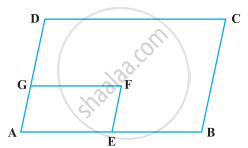Advertisements
Advertisements
Question
In the Figure, ABCD is a rectangle and EFGH is a parallelogram. Using the measurements given in the figure, what is the length d of the segment that is perpendicular to `bar("HE")` and `bar("FG")`?
Solution
In the given figure ABCD is a rectangle and EFGH is a parallelogram.
In the right triangle AEH
HE = `sqrt("AH"^2 + "AE"^2)`
= `sqrt(3^2 + 4^2)`
= `sqrt(9 + 16)`
= `sqrt(25)`
HE = 5
∴ GF = 5 ...(HE and Gf are opposite sides of a parallelogram)
In the right triangle
GC = `sqrt("GF"^2 - "FC"^2)`
= `sqrt(5^2 - 3^2)`
= `sqrt(25 - 9)`
= `sqrt(16)`
∴ DG = 10 – 6 = 4
Area of ΔAEH + Area of ΔBEF + Area of ΔFCG + Area of ΔHDG
= `1/2 xx 3 xx 4 + 1/2 xx 6 xx 5 + 1/2 xx 3 xx 4 + 1/2 xx 5 xx 6`
= (6 + 15 + 6 + 15)
= 42
∴ Area of 4 triangles = 42
Area of the parallelogram = Area of the rectangle ABCD – Area of 4 triangles.
= 10 × 8 – 42
= 80 – 42
= 38
b × h = 38
5 × d = 38
d = `38/5`
= `7 3/5`
Length of d = `7 3/5` or 7.6
APPEARS IN
RELATED QUESTIONS
The diagonal BD of a parallelogram ABCD bisects angles B and D. Prove that ABCD is a rhombus.
In the alongside diagram, ABCD is a parallelogram in which AP bisects angle A and BQ bisects angle B.

Prove that:
- AQ = BP
- PQ = CD
- ABPQ is a parallelogram.
In the given figure, ABCD is a parallelogram.
Prove that: AB = 2 BC.
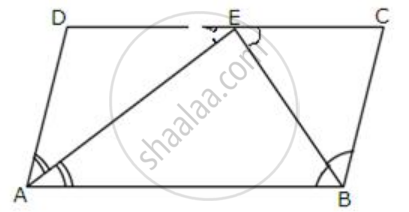
PQRS is a parallelogram. T is the mid-point of PQ and ST bisects ∠PSR.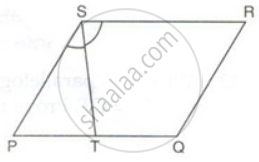
Prove that: ∠RTS = 90°
In the given figure, MP is the bisector of ∠P and RN is the bisector of ∠R of parallelogram PQRS. Prove that PMRN is a parallelogram.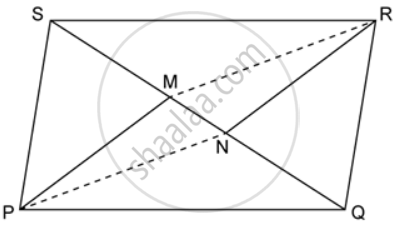
In a parallelogram ABCD, E is the midpoint of AB and DE bisects angle D. Prove that:CE is the bisector of angle C and angle DEC is a right angle
In the given figure, the perimeter of parallelogram PQRS is 42 cm. Find the lengths of PQ and PS.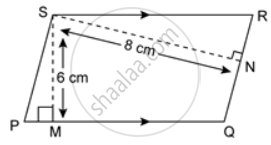
In parallelogram ABCD of the accompanying diagram, line DP is drawn bisecting BC at N and meeting AB (extended) at P. From vertex C, line CQ is drawn bisecting side AD at M and meeting AB (extended) at Q. Lines DP and CQ meet at O. Show that the area of triangle QPO is `9/8` of the area of the parallelogram ABCD
Which of the following statement is correct?
In the following figure, ABCD and AEFG are two parallelograms. If ∠C = 55º, determine ∠F.
